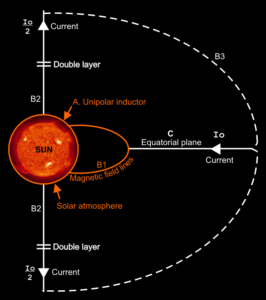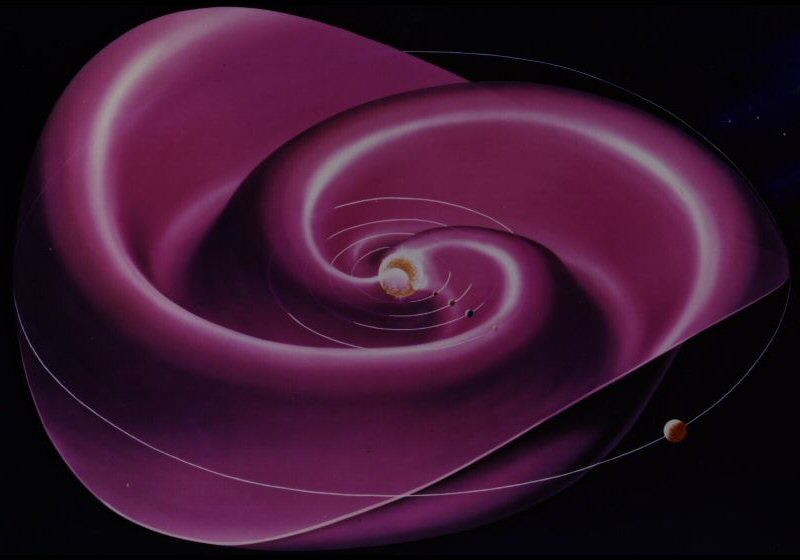Just as electric currents generate magnetic fields described by Ampere’s law, changing magnetic fields in a plasma (consisting of charged particles) generate electric currents that are described by Faraday’s law. The characteristics of the electric current and magnetic field depend on the characteristics and nature of the plasma.
In other words, electric currents produce magnetic fields which in turn produce electric currents. They are sometimes described as a self-generated electric and magnetic fields, and Birkeland currents, and field aligned currents.
Rotating plasma in a magnetic field generates electric currents because it behaves as unipolar generator, also known as a Faraday disk, or magnetic dynamo.
Contents
Typical cosmic electric currents
The Sun and stars

The high density plasma in the Sun (and stars), is known to produce current loops in solar flares,[2] [3] [4] [5] current sheets in the Solar Corona,[6] and general twisting electric current helicity in the solar atmosphere.[7] Electric Currents have also been proposed as the main cause of coronal and flare activity in the Sun.[8]
Ionosphere
The medium density terrestrial and planetary ionospheres are known to produce Birkeland currents in the aurora of the Earth, Jupiter, Saturn and Mars. (Main article: Birkeland current) Planetary magnetospheres such as the Earth,[9] Saturn, Jupiter and its moon Io, also produce an electric ring current; the Earth’s ring current is stable and does not rotate, but Saturn’s ring current is lop-sided rotates with the planet.[10]
Types of current in planetary magnetospheres
Ref.[11]
- Parallel (to B)
-
- Upward
- Downward
- Perpendicular (to B)
-
- Magnetization
- Drift
-
- Gradient drift current (dominates in Earth’s inner magnetosphere/ring current region)
- Curvature drift current.
- Centrifugal drift current (dominates in the rapidly rotating magnetospheres of Jupiter and Saturn.)
- Acceleration drift current (dominates in regions of high-speed flow (boundary layers, magnetotail))
- Conduction (Pedersen + Hall)
Interplanetary medium (Solar wind)
The tenuous interplanetary medium (between the Sun and planets) is known to produce the heliospheric current sheet, whose currents are represented by the Heliospheric current circuit. (Main article: heliospheric current sheet)
The more tenuous interstellar medium (between solar systems) produces a current sheet,[12] and electric currents have also been described in interstellar molecular clouds.[13]
In 2007, the Themis satellite “found evidence of magnetic ropes connecting Earth’s upper atmosphere directly to the sun [in which] a burst of electrical current within the solar wind will hit the bow shock and—Bang! We get an explosion”[14] [15]
Intergalactic medium
The most tenuous intergalactic medium (between galaxies) has been calculated to carry current of 1017 – 1019 Amps.[16] In 2011, it was reported that a current of about 1018 amps was found emanating from a cosmic jet stretching for 150,000 light years across galaxy 3C303.[17][18][19]
Jets
Electric currents have also been proposed in astrophysical jets (particle beams)[20] [21], including extragalactic jets,[22] including:
- “.. the radio jet of the galaxy 3C303. From these data we derive the magnetoplasma and electrodynamic parameters of this 50 kpc long jet. For one component of this jet we obtain for the first time a direct determination of a galactic-scale electric current (∼3 × 1018 A), and its direction — positive away from the active galactic nucleus. Our analysis strongly supports a model where the jet energy flow is mainly electromagnetic..”[23]
History
In 1942, Hannes Alfvén wrote in a letter to the journal, Nature:
- “If a conducting liquid is placed in a constant magnetic field, every motion of the liquid gives rise to an E.M.F. which produces electric currents. Owing to the magnetic field, these currents give mechanical forces which change the state of motion of the liquid.”
- “Thus a kind of combined electromagnetic-hydrodynamic wave is produced [..]
- “Waves of this sort may be of importance in solar physics. As the sun has a general magnetic field, and as solar matter is a good conductor, the conditions for the existence of electromagnetic-hydrodynamic waves are satisfied.”[24]
Notes
- ↑ Israelevich, P. L., et al, “MHD simulation of the three-dimensional structure of the heliospheric current sheet” FULL TEXT (2001) Astronomy and Astrophysics, v.376, p.288-291. PEER REVIEWED
- ↑ Hannes Alfvén, per Carlqvist “Currents in the Solar Atmosphere and a Theory of Solar Flares” FULL TEXT (1967) Solar Physics, Vol. 1, p.220 PEER REVIEWED
- ↑ Carlqvist, P., “Current Limitation and Solar Flares” FULL TEXT (1969) Solar Physics, Vol. 7, p.377 PEER REVIEWED
- ↑ Karlicky, M., “Evolution of force-free electric currents in the solar atmosphere” FULL TEXT (1997) Astronomy and Astrophysics, v.318, p.289-292 PEER REVIEWED
- ↑ Zaitsev, V. V.; Stepanov, A. V., “Towards the circuit theory of solar flares” FULL TEXT (1992) Solar Physics (ISSN 0038-0938), vol. 139, no. 2, June 1992, p. 343-356 PEER REVIEWED
- ↑ Strauss, H. R.; Otani, N. F., “Current sheets in the solar corona” FULL TEXT (1988) Astrophysical Journal, Part 1 (ISSN 0004-637X), vol. 326, March 1, 1988, p. 418-424 FULL TEXT
- ↑ Seehafer, N., “Electric current helicity in the solar atmosphere” FULL TEXT (1990) Solar Physics (ISSN 0038-0938), vol. 125, Feb. 1990, p. 219-232. PEER REVIEWED
- ↑ Feldman, U., “Electric Currents as the Main Cause of Coronal and Flare Activity in the Sun and in Many Late-Type Stars” (2002) Physica Scripta, Volume 65, Issue 2, pp. 185-192. PEER REVIEWED
- ↑ Williams, D. J.”The earth’s ring current: Causes, generation, and decay – /Tutorial Lecture/” {full} (1983) (COSPAR, IAU, IUGG, IUPAP, and URSI, International Symposium on Progress in Solar-Terrestrial Physics, 5th, Ottawa, Canada, May 17-22, 1982.) Space Science Reviews, vol. 34, Mar. 1983, p. 223-234. PEER REVIEWED
- ↑ “Mysterious Twist Found in Saturn’s Electric Ring” from space.com, retrieved 24 Aug 2007
- ↑ T. W. Hill, “Currents“FULL TEXT PDF Rice University, Houston, Texas, USA
- ↑ Zweibel, Ellen G.; Brandenburg, Axel, “Current Sheet Formation in the Interstellar Medium” (1997) Astrophysical Journal v.478, p.563 PEER REVIEWED. See also Erratum.
- ↑ Carlqvist, Per; Gahm, Gosta F., “Manifestations of electric currents in interstellar molecular clouds” (1992) IEEE Transactions on Plasma Science (ISSN 0093-3813), vol. 20, no. 6, p. 867-873. (Dec 1992) PEER REVIEWED
- ↑ “NASA Spacecraft Make New Discoveries About Northern Lights” FULL TEXT, NASA Themis Press Release
- ↑ “THEMIS probes view auroral substorms, bowshock explosions” FULL TEXT, University of California – UC Newsroom, 2007-12-11 (via archive.org)
- ↑ Hannes Alfvén and Per Carlqvist, “Interstellar clouds and the formation of stars” (1978) FULL TEXT in Astrophysics and Space Science, vol. 55, no. 2, May 1978, p. 487-509. PEER REVIEWED
- ↑ Clay Dillow, “The Strongest Electrical Current in the Universe Spotted, 2 Billion Light Years From Here“, Posted 06.22.2011.
- ↑ Philipp P. Kronberg, Richard V. E. Lovelace, Giovanni Lapenta, Stirling A. Colgate, “Measurement of the Electric Current in a Kpc-Scale Jet“, Arxiv.org, v3, 19 Dec 2011 FULL TEXT
- ↑ Philipp P. Kronberg, Richard V. E. Lovelace, Giovanni Lapenta, Stirling A. Colgate, “Measurement of the Electric Current in a Kpc-Scale Jet”, The Astrophysical Journal Letters, Volume 741 Number 1 PEER REVIEWED
- ↑ Appl, S.; Camenzind, M. “The stability of current-carrying jets” FULL TEXT (1992) Astronomy and Astrophysics (ISSN 0004-6361), vol. 256, no. 2, p. 354-370 PEER REVIEWED
- ↑ Baty, H. “On the magnetohydrodynamic stability of current-carrying jets” (2005) Astronomy and Astrophysics, v.430, p.9-17 PEER REVIEWED
- ↑ Jafelice, Luiz C.; Opher, Reuven; Assis, Altair S.; Busnardo-Neto, Jose, “Current generation in extragalactic jets by Cherenkov damping of magnetohydrodynamic waves” FULL TEXT (1990) Astrophysical Journal, Part 1 (ISSN 0004-637X), vol. 348, Jan. 1, 1990, p. 61-72 PEER REVIEWED
- ↑ P. P. Kronberg et al., “Measurement of the Electric Current in a Kpc-Scale Jet“, The Astrophysical Journal Letters Volume 741 Number 1, 2011 ApJ 741 L15 PEER REVIEWEDFULL TEXT
- ↑ Hannes Alfvén, “Existence of electromagnetic-hydrodynamic waves“, Nature, Vol. 150, pp. 405, 1942 PEER REVIEWED FULL TEXT
References
- Alfvén, H.; Carlqvist, P., “Currents in the Solar Atmosphere and a Theory of Solar Flares” FULL TEXT, Solar Physics, Vol. 1, p.220, 1967 PEER REVIEWED
- Alfvén, H., “On the Importance of Electric Fields in the Magnetosphere and Interplanetary Space“,FULL TEXT Space Science Reviews, vol. 7, p.140, 1967 PEER REVIEWED
- Carlqvist, Per, “Cosmic electric currents and the generalized Bennett relation“,FULL TEXT Astrophysics and Space Science (ISSN 0004-640X), vol. 144, no. 1-2, May 1988, p. 73-84. PEER REVIEWED
- Peratt, Anthony L., “The role of particle beams and electrical currents in the plasma universe“, Laser and Particle Beams (ISSN 0263-0346), vol. 6, Aug. 1988, p. 471-491. full text FULL TEXT PDF PEER REVIEWED
- Peratt, Anthony L., “The evidence for electrical currents in cosmic plasma“, IEEE Transactions on Plasma Science (ISSN 0093-3813), vol. 18, Feb. 1990, p. 26-32 full text FULL TEXT PDF PEER REVIEWED
- Meierovich, Boris E.; Peratt, Anthony L., “Equilibrium of intergalactic currents“, IEEE Transactions on Plasma Science (ISSN 0093-3813), vol. 20, no. 6, p. 891, 892. Full text FULL TEXT PDF PEER REVIEWED
- Peratt, A. L., “Electric space: evolution of the plasma universe“,FULL TEXT Astrophysics & Space Science, 244, 89-103 (1996) PEER REVIEWED
